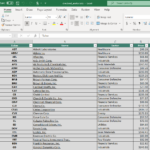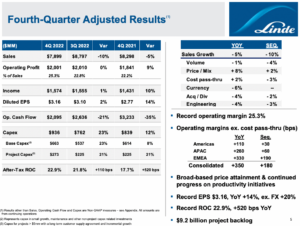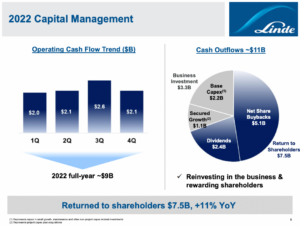Updated on February 12th, 2023 by Felix Martinez
The Dividend Aristocrats represent a group of 68 stocks in the S&P 500 Index, each with at least 25 consecutive years of dividend increases.
The Dividend Aristocrats are among the highest-quality dividend growth stocks in the entire stock market. For this reason, we individually review every Dividend Aristocrat each year.
You can download your full list of all 68 Dividend Aristocrats (along with important financial metrics like price-to-earnings ratios and dividend yields) by clicking on the link below:
The next installment of the 2023 series takes a closer look at Linde plc (LIN), which qualifies on the list as a result of its acquisition of Praxair, a former Dividend Aristocrat.
The Praxair acquisition should be a meaningful growth catalyst for many years to come. As a result, we view Linde favorably as a dividend growth stock, albeit one with an elevated valuation.
Business Overview
Linde plc – which was created through the merger of Linde AG and Praxair – is the world’s largest industrial gas corporation. Linde AG is headquartered in the U.K. following the merger. The company produces, sells, and distributes atmospheric, process, and specialty gases, along with high-performance surface coatings.
Linde products and services can be found in nearly every industry in more than 100 countries worldwide. The combined company now generates over $33.4 billion of annual revenue. Linde is a large-cap stock with a market capitalization of $163 billion.
The company operates in five segments: Americas, EMEA, APAC, Engineering, and Global Other. Linde gases are used in a variety of industries, including energy, steel production, chemical processing, environmental protection, food processing, electronics, and more. The company also has a healthcare business consisting of medical gases and services.
Linde’s exposure to any particular geographical area has been improved thanks to the merger, as it now has a strong, global customer base across various industries. Indeed, Linde now serves customers in more than 100 countries around the world. In addition, it has scale and size, unlike any competitor, putting it in an enviable position.
The company struggled in 2020 as the coronavirus pandemic and supply chain issues sent the U.S. economy into recession. Still, the company remained highly profitable, with a strong ROIC in 2020, 2021, and in 2022.
Source: Investor Presentation
In 2022, revenue was up 8% to $33.4 billion. Still, the company grew its adjusted earnings-per-share by 14.9% for the entire year as operating profit margins expanded by 40 basis points last year.
The revenue increase for 2022 reflected the company’s reliance on a healthy economy. That said, Linde’s revenue performance improved as the year progressed.
Fourth-quarter revenues totaled $7.9 billion, down 5% from the previous year’s fourth quarter. This was due to lower sales growth in Asia Pacific and EMEA (Europe, Middle East & Africa), which saw sales decline by 1% and 2%, respectively.
Linde was also able to grow its profit margins meaningfully, which allowed for stronger earnings growth during the quarter. Earnings–per–share for the fourth quarter totaled $2.67, which was up 35% versus the same quarter a year ago.
Growth Prospects
The Praxair merger has been Linde’s primary driver of growth in recent years, with 2022 results continuing to show the margin expansion benefits of the acquisition. Even though sales fell in the fourth quarter, Linde produced double-digit adjusted EPS growth. Cost savings result in much higher operating margins, growing earnings much faster than revenue.
The company’s increased cash flow can be seen in the image below:
Source: Investor Presentation
This slide gives us an overview of the types of savings the company expects to accrue over time and the methods via which those synergies will be achieved. These synergies continue to accrue, meaning margins could continue to improve in 2023 and beyond.
Share repurchases will also majorly catalyze Linde’s future earnings growth. Linde completed net share repurchases of $5.1 billion in 2022. This is impressive, as many companies curtailed share buybacks to preserve cash.
In addition, the dividend was recently raised, once again, by 10% in 2022. Linde is very serious about its capital returns as the business generates more cash than it can profitably invest, leading to these strong buybacks and dividend numbers.
We expect Linde to grow its earnings-per-share by 6% per year over the next five years. We see revenue growth as modest, in addition to a small tailwind from margin growth and a lower share count, respectively.
Competitive Advantages & Recession Performance
Linde enjoys multiple competitive advantages. As a leader in industrial gases, the company enjoys economic scale and greater operational efficiency than its smaller competitors.
In addition, Linde’s financial resources allow the company to invest heavily in research and development. Linde spent about $143 million on R&D in 2022 to build and maintain its competitive advantages.
Another competitive advantage is Linde’s strong financial position. The company has a healthy balance sheet, with high credit ratings of ‘A2’ from Moody’s and ‘A’ from Standard & Poor’s. Given that total liabilities have fallen since the merger was completed, we expect these credit ratings to be stable. Maintaining investment-grade credit ratings helps the company access capital markets at an attractive cost, which means Linde can spend its cash on things like dividends and buybacks.
On the other hand, Linde is not a recession-resistant business. As a global industrial manufacturer, its business model is sensitive to fluctuations in the global economy. An economic downturn typically sees lower demand from industrial customers.
Linde’s earnings-per-share during the Great Recession are as follows:
• 2008 earnings-per-share of $4.19
• 2009 earnings-per-share of $4.01 (4.3% decline)
• 2010 earnings-per-share of $3.84 (4.2% decline)
• 2011 earnings-per-share of $5.45 (42% increase)
The company saw a modest decline in earnings-per-share during the recession but fortunately saw its earnings improve alongside the broader global economic recovery. By 2011, Linde’s earnings had surpassed 2008 levels. We expect Linde’s revenue and margins to suffer during the next recession, but note that its current growth outlook is robust.
Valuation & Expected Returns
Linde is expected to generate earnings-per-share of $13.34 for 2023. Based on this, shares currently trade for a price-to-earnings ratio of 26.8. This is a high valuation for the stock, even though the company is highly profitable and growing earnings at a satisfactory rate. In addition, we see Linde as receiving a premium valuation due to its unmatched competitive position in the industry it serves.
Our fair value estimate for the stock is a price-to-earnings ratio of 21. This is a reasonable, fair-value target for a strong company with durable competitive advantages.
As a result, Linde appears to be overvalued. If shares were to experience a falling valuation to reach our fair value estimate, it would reduce annual returns by 3.9% per year. This represents a strong headwind for investors buying at the current price level.
Future returns will be boosted by earnings growth and dividends. In addition to Linde’s expected earnings growth of 6% per year over the next five years, the stock has a current annualized dividend yield of 1.4%.
Linde can certainly be classified as a dividend-growth stock. The most recent quarterly dividend payout was increased by 10% from the previous dividend.
The combination of valuation changes, earnings growth, and dividends results in total expected returns of 3.5% per year over the next five years. The valuation headwind will virtually offset earnings-per-share growth and the dividend yield, and we see the stock as unattractive.
Linde is a very profitable company with positive earnings and dividend growth outlooks, but the impact of overvaluation is enough to warrant a sell recommendation at the current price.
Final Thoughts
Linde stock has performed well since the merger with Praxair. Expectations are high for the combined company’s potential, but, at this time, we feel Linde’s stock is significantly overvalued.
Linde will be an industry leader with clear and durable competitive advantages. The company should grow revenue and earnings at a steady rate going forward, assuming the global economy stays out of recession.
However, while Linde is a strong business, the stock is too richly valued to buy today. While Linde should continue to raise its dividend each year, investors should wait for a significant decline in the share price before buying Linde stock.
If you are interested in finding more high-quality dividend growth stocks suitable for long-term investment, the following Sure Dividend databases will be useful:
- The 20 Highest Yielding Dividend Aristocrats
- The Dividend Kings List is even more exclusive than the Dividend Aristocrats. It is comprised of 40 stocks with 50+ years of consecutive dividend increases.
- The 20 Highest Yielding Dividend Kings
- The Dividend Achievers List: a group of stocks with 10+ years of consecutive dividend increases.
- The Dividend Champions List: stocks that have increased their dividends for 25+ consecutive years.
Note: Not all Dividend Champions are Dividend Aristocrats because Dividend Aristocrats have additional requirements like being in The S&P 500. - The Dividend Contenders List: 10-24 consecutive years of dividend increases.
- The Dividend Challengers List: 5-9 consecutive years of dividend increases.
- The Monthly Dividend Stocks List: contains stocks that pay dividends each month, for 12 payments per year.
- The 20 Highest Yielding Monthly Dividend Stocks
- The High Dividend Stocks List: high dividend stocks are suited for investors that need income now (as opposed to growth later) by listing stocks with 5%+ dividend yields.
The major domestic stock market indices are another solid resource for finding investment ideas. Sure Dividend compiles the following stock market databases and updates them monthly:


